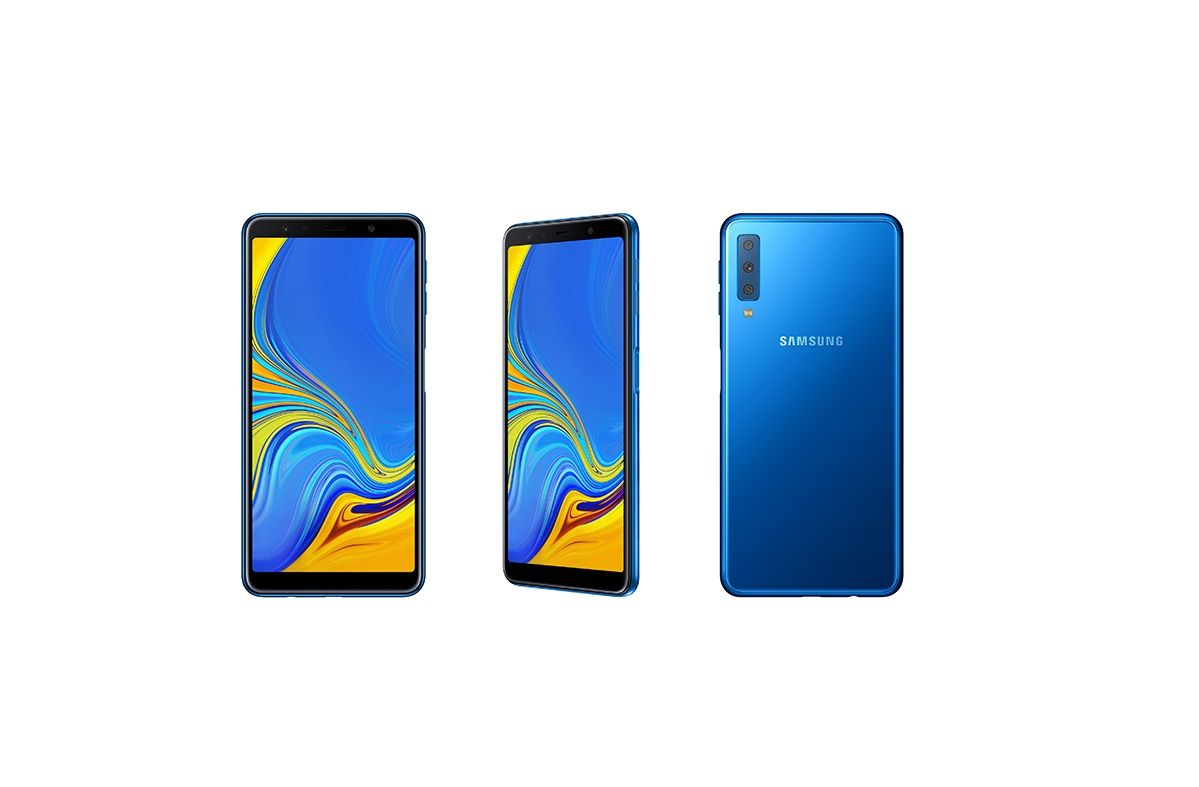In 2018, smartphones are launching at an increasingly quick rate. The mid-range segment was a bit barren for a few years, but this year, companies like Xiaomi, Samsung, OPPO, Vivo, Nokia, and others are filling the gap. With respect to the Galaxy A series, Samsung has already launched the Galaxy A6, Galaxy A6+, Galaxy A8, Galaxy A8+, and the Galaxy A8 Star this year. The Galaxy A series is typically not competitive against affordable flagships from the likes of Xiaomi, Asus, and OnePlus, and the aforementioned phones haven't done anything to change this fact. Samsung, however, isn't giving up. The Samsung Galaxy A7 (2018) has now been launched in India, and its defining feature is the presence of triple rear cameras.
The Galaxy A7 (2018) is the successor to the Galaxy A7 (2017), which was announced back in January 2017. The Galaxy A7 (2018) was announced last week, and now, it has made its way to India. The phone contains several important hints for next year's Galaxy S10 series. Firstly, it has a side-mounted fingerprint sensor instead of a back-mounted one, matching the rumored entry-level Galaxy S10, which is also reported to have a side-mounted fingerprint sensor.
Secondly, it has triple rear cameras---matching the Galaxy S10+, which is also rumored to have triple rear cameras. Now the Galaxy A7's cameras shouldn't be expected to be on par with something like the Huawei P20 Pro's triple camera setup, but the phone itself is noteworthy for being the first Samsung phone to have three rear cameras.
The Galaxy A7 (2018) is a standard mid-range phone in other respects such as the SoC and battery. Its full specifications are noted below:
Samsung Galaxy A7 (2018) - Specifications at a glance
|
Category |
Samsung Galaxy A7 (2018) |
|---|---|
|
Dimensions and Weight |
159.8 x 76.8 x 7.5 mm, 168g |
|
CPU |
Exynos 7885 @ 2.2GHz |
|
GPU |
ARM Mali-G71 |
|
RAM |
4GB/6GB |
|
Rear Cameras |
24MP (AF, f/1.7 aperture) + 8MP (wide-angle, f/2.4 aperture) + 5MP (depth-sensing, f/2.2 aperture) w/ LED flash |
|
Front Camera |
24MP, f/2.0 aperture |
|
Storage |
64GB/128GB, expandable up to 512GB via microSD |
|
Display |
6.0-inch 1080×2220 18.5:9 Super AMOLED Infinity Display, 411 PPI |
|
Audio |
3.5mm headphone jack, speaker, FM Radio |
|
Battery |
3,300mAh battery |
|
Ports |
micro-USB (USB 2.0) |
|
Fingerprint scanner |
Yes (side-mounted) |
|
Software |
Android 8.0 Oreo (Samsung Experience 9.0) |
|
Connectivity |
Dual SIMWi-Fi 802.11 a/b/g/n/ac (2.4 GHz/5GHz)Bluetooth 5.0LTE with VoLTEGPS / GLONASS |
|
Colors |
Striking Blue, Premium Black, and Gold Millenial colors |
The Galaxy A7 (2018) also features support for Dolby Atmos. In terms of hardware, the phone has a metal frame and a glass back. The triple rear cameras are placed at the top left on the back.
The Exynos 7885 SoC's performance falls below that of the Qualcomm Snapdragon 660. It has two Arm Cortex-A73 cores clocked at 2.2GHz, which are paired with six Arm Cortex-A53 cores clocked at 1.6GHz. The GPU used is the Arm Mali-G71MP2, which is weaker than even the MediaTek Helio P60's Mali-G72MP3 GPU. The SoC's performance is even weaker than the Snapdragon 636.
Unfortunately, this means it's not going to compete with the Qualcomm Snapdragon 660, Qualcomm Snapdragon 670 or the Qualcomm Snapdragon 710. Also, it's almost needless to note that the Qualcomm Snapdragon 845 is in another league. To put it simply, phones like the Xiaomi Poco F1 are available for cheaper prices while offering more performance.
The Galaxy A7 (2018) also fails to impress when it comes to connectivity. A micro-USB port should not be expected to seen in an upper mid-range phone, as USB Type-C is now increasingly being adopted in this price range.
Samsung Galaxy A7 (2018) - Pricing and availability
The Samsung Galaxy A7 (2018) will be available for ₹23,990 ($330) in India for the base 4GB RAM/64GB storage variant. The 6GB RAM/128GB storage variant costs ₹28,990 ($398). The phone will be available via Flipkart, Samsung Shop, and the Samsung Opera House on September 27 and September 28 before going on sale via other offline channels. Launch offers include ₹2,000 cashback on HDFC bank credit and debit card purchases.
In terms of competition, the Galaxy A7 (2018) faces broad competition including but not limited to the Xiaomi Mi A2, the Xiaomi Poco F1, the upcoming Realme 2 Pro, the Honor Play, the OPPO F9/F9 Pro, the Vivo V11 and the Vivo V11 Pro, the Nokia 7 Plus, and others. The phone still isn't on par with its competitors in terms of value, as the absence of a high-end SoC hinders it when compared with competitors such as the Poco F1 and the Honor Play.
What are your thoughts regarding the Samsung Galaxy A7 (2018)? Do you think triple rear cameras can help Samsung differentiate its mid-range phones? Let us know in the comments below.

